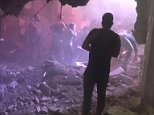Stunning video reveals the massive 'firehose of lava' flowing from Hawaii's Kilauea volcano into the sea
- Molten lava from Kilauea volcano in Hawaii is dumping directly into the Pacific
- Massive lava stream is roughly 1-2 meters wide, spewing as a 'single large spout'
- This creates dangerous explosions as the hot lava interacts with the cool sea
The Kilauea volcano is spewing molten lava into the Pacific Ocean, spurring explosions that launch debris to twice the height of the sea cliff.
Footage captured by the USGS’s Hawaiian Volcano Observatory reveals the remarkable volcanic ‘firehose’ in action as it produces dangerous blasts, creating 'hazardous conditions on land and at sea.'
Upon a careful examination of the ‘unstable sea cliff’ this past weekend, researchers discovered a hot crack just above the site where the lava is flowing out, with temperatures as high as 428 degrees Fahrenheit.
Scroll down for video

Footage captured by the USGS’s Hawaiian Volcano Observatory reveals the remarkable volcanic ‘firehose’ in action as it produces dangerous blasts, creating 'hazardous conditions on land and at sea'
The massive lava stream is roughly 1-2 meters wide and has been continuously pouring molten lava directly into the water at the Kamokuna ocean entry, according to the US Geological Survey.
It’s recently begin to flow from the lava tube as a ‘single large spout,’ causing pulsating blasts of molten fragments.
‘At Kilauea’s ocean entry on Jan 28 and 29, the interaction of molten lava flowing into cool seawater caused pulsating littoral explosions that threw spatter (fragments of molten lava) high into the air,’ the USGS HVO explains.
‘Some of these incandescent clasts fell on top of the sea cliff behind the ocean entry, forming a small spatter cone. During one exceptionally large burst, spatter as thrown about twice the height of the sea cliff.
‘These ocean entry littoral explosions, both large and small create hazardous conditions on land and at sea.’


The massive lava stream is roughly 1-2 meters wide and has been continuously pouring molten lava directly into the water at the Kamokuna ocean entry, according to the US Geological Survey
With the discovery of a hot ground crack in the sea cliff overhead, the site is considered to be extremely unstable.
But, geologists set out for a closer investigation on foot January 28 wearing protective gear.
The team found that the eastern end of the crack is roughly 11.8 inches (30 cm) wide, and ‘deeply cut into recent lava atop the older sea cliff.’
They were unable to access the western end as a result of numerous safety concerns, including poor air quality and the unstable ground.

‘At Kilauea’s ocean entry on Jan 28 and 29, the interaction of molten lava flowing into cool seawater caused pulsating littoral explosions that threw spatter (fragments of molten lava) high into the air,’ the USGS HVO explains

Upon a careful examination of the ‘unstable sea cliff’ this past weekend, researchers discovered a hot crack just above the site where the lava is flowing out, with temperatures as high as 428 degrees Fahrenheit
‘This crack could be a precursor to collapse of an unstable section fo the sea cliff, making the site extremely dangerous for anyone who ventures too closely to the ocean entry by land or by sea,’ the USGS explains.
Thermal imaging has revealed that the hot crack reaches 428 degrees Fahrenheit (220 degrees Celsius) in the eastern end.
The lava flow streaming below continued on at a somewhat steady rate across last week, occasionally appearing wider and with holes in the sheet.


‘Some of these incandescent clasts fell on top of the sea cliff behind the ocean entry, forming a small spatter cone,' the USGS wrote. 'During one exceptionally large burst, spatter as thrown about twice the height of the sea cliff.'

The Kilauea volcano is spewing molten lava into the Pacific Ocean, spurring explosions that launch debris to twice the height of the sea cliff
Most watched News videos
- Shocking moment two commuters have sex at Melbourne train station
- Shocking video of three vehicle crash but everyone walks away!
- 'Drugged-up' store clerks appear to fall asleep at the register
- Investigators at the scene of fatal crash that killed five
- Emergency services on the scene following fatal car crash in Leeds
- Octopus outsmarts predator in a way the world has never seen
- Anette Sørensen talks about her book 'A Worm in The Apple'
- Devastation at Cocoanut Grove after deadly fire in 1942
- Mysterious fireball seen blazing in the sky in south of England
- Royal Navy perform Changing the Guard ceremony in historic first
- Iran reveals more allegations against Nazanin Zaghari-Ratcliffe
- Duke and Duchess arrive at the Royal Variety Performance in London
-
 Five victims of stolen car horror: Renault Clio smashes...
Five victims of stolen car horror: Renault Clio smashes... -
 'My father was a paedophile. He thought innocence was an...
'My father was a paedophile. He thought innocence was an... -
 Shocking moment a couple are caught on camera having SEX...
Shocking moment a couple are caught on camera having SEX... -
 Could Harry and Meghan announce engagement on TUESDAY?...
Could Harry and Meghan announce engagement on TUESDAY?... -
 Meghan Markle is being guarded by royal protection...
Meghan Markle is being guarded by royal protection... -
 Amazon staff blast 'intolerable' conditions: Warehouse...
Amazon staff blast 'intolerable' conditions: Warehouse... -
 'Show us this monster': James Bulger's father demands...
'Show us this monster': James Bulger's father demands... -
 Dozens were killed in earthquakes triggered by Kim...
Dozens were killed in earthquakes triggered by Kim... -
 Shocking video shows the moment a nightclub floor...
Shocking video shows the moment a nightclub floor... -
 Overtaking driver sends two cars and a van careering off...
Overtaking driver sends two cars and a van careering off... -
 Iran 'has more evidence' that could add 16 years to...
Iran 'has more evidence' that could add 16 years to... -
 Bringing colour to the bloody battle of Tarawa: Never...
Bringing colour to the bloody battle of Tarawa: Never... -
 Incredible moment residents of tiny Hawaiian island...
Incredible moment residents of tiny Hawaiian island... -
 'Thanks for ruining my holiday!' Thousands of angry...
'Thanks for ruining my holiday!' Thousands of angry... -
 Susan Sarandon is glad 'dangerous' Hillary didn't win...
Susan Sarandon is glad 'dangerous' Hillary didn't win... -
 Second Labour member has been found DEAD in an apparent...
Second Labour member has been found DEAD in an apparent... -
 Banking heir, 52, turns 275-acre backyard into a...
Banking heir, 52, turns 275-acre backyard into a... -
 Not so retired after all! Usain Bolt spends wild night...
Not so retired after all! Usain Bolt spends wild night...





















































































































































































































































